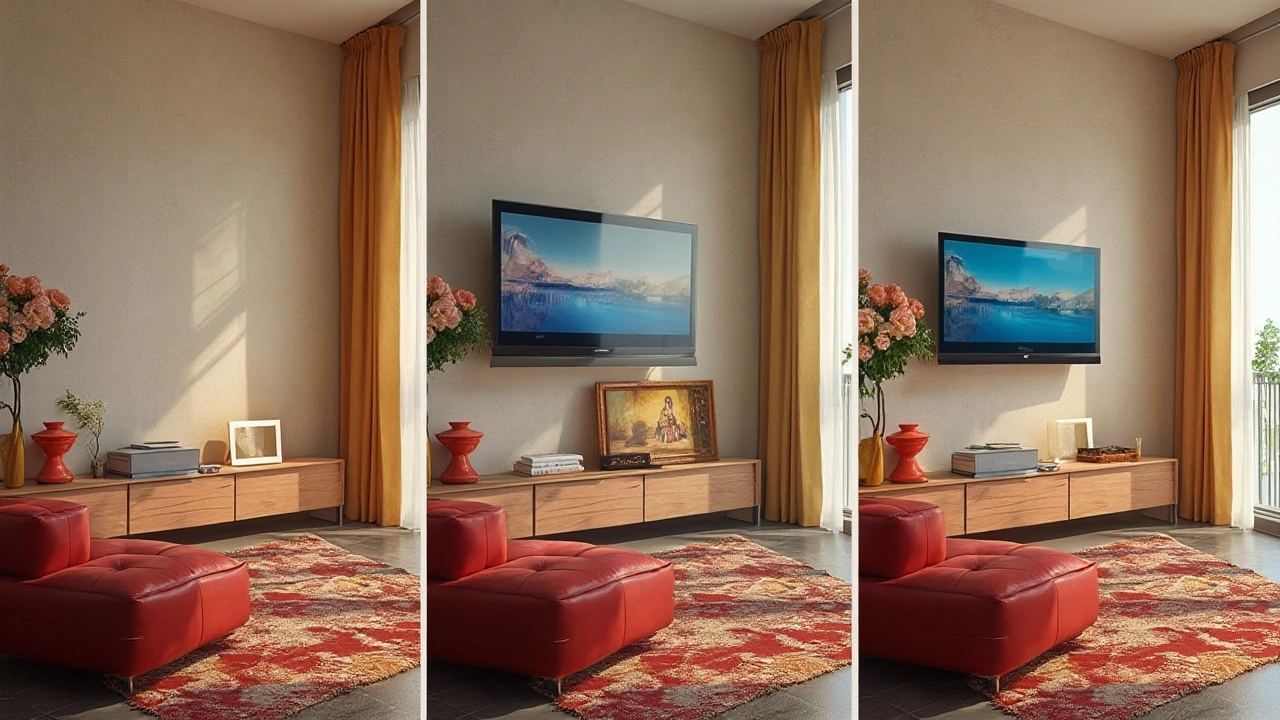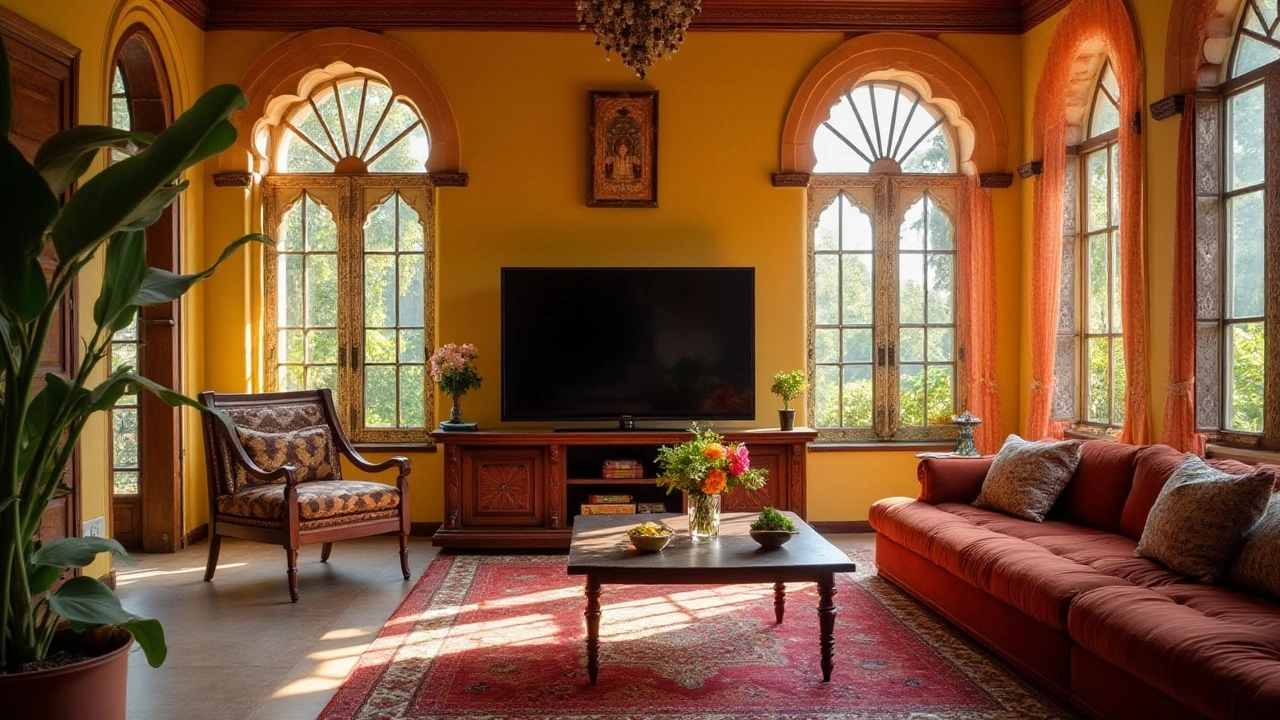When it comes to setting up your living room, the placement of the television can either make or break the harmony of the space. While it might be tempting to place your TV just anywhere that seems convenient, it's crucial to consider some common placement pitfalls.
Choosing the right spot not only enhances your viewing experience but also complements the room's decor. Avoiding strategic blunders will help in crafting a space that is both aesthetically pleasing and practical.
- Above the Fireplace
- Opposite Windows
- Near Frequent Traffic Areas
- Too High on the Wall
- Adjacent to Multiple Screens
- In Poorly Ventilated Corners
Above the Fireplace
Placing a television above the fireplace is a common trend in modern living room setups, often driven by a promise of sleek design and space efficiency. However, this choice often comes at the cost of comfort and long-term usage. The focal point created by a fireplace can sometimes overwhelm a TV, causing viewers to constantly lift their heads, leading to neck strain from prolonged viewing sessions. Not to mention, placing a TV up high generally is ergonomically unsound, as experts from the Vision Council often advise planting your screen at eye level for a comfortable setup.
Another concern with positioning your TV above the fireplace is the heat aspect. Fireplaces are designed to radiate warmth, which may not bode well for electronics' longevity. Sustained heat exposure can affect the performance of the TV, potentially leading to quicker depreciation over time. If you do choose this placement out of necessity, using a mantel or a fireplace hood may help to shield and mitigate some of the heat. Additionally, checking if the TV stand or wall mount has a tilt function might help maintain a better line of sight as you watch.
"When we create spaces, it's always important to prioritize comfort over trend. It's about making a home feel as good as it looks." — Nate Berkus, Interior Designer
On the visual front, a fireplace typically demands the attention of a room, and a TV could compete with this feature instead of complimenting it. Achieving balance in interior decor is crucial, which often means allowing enough space for each element to shine. In fact, if the statures are difficult to manage, think about creating a cozy reading nook near the fireplace and relocating the television to an area less obstructive to natural focus.
Additionally, if you do decide to install the TV here, keeping it at least two feet apart from the heat source seems to be a universal recommendation. Moreover, an important design principle is to outline your space that feels both lively and functional, something a misplaced TV can disrupt. Understand the line between practical and hype—a visually stimulating room doesn’t necessarily benefit from sacrificing ease of use, an aspect that can suffer if the TV is too high. Consider how often you use the fireplace versus the TV; the most frequently used should dictate where to compromise.
Opposite Windows
Placing your television opposite windows can lead to a number of visual issues, primarily because natural light often shines directly on the screen. This can create distracting glares and reflections, which not only diminish the viewing experience but can also strain your eyes over time. Picture this: You're trying to enjoy a Sunday afternoon movie, but instead, you're squinting at tiny reflections of the outside world dancing across the screen. It’s far less than ideal.
Natural light is, without a doubt, a crucial element in any living space, bringing cheer and openness to a room. However, when it comes to your TV's location, it should be managed with a knack for balance. A simple, yet effective solution is to use blinds or curtains to control the amount of light pouring in, ensuring the screen remains glare-free during your must-watch shows or games.
An alternative tip that’s often overlooked is enhancing the angle of your TV screen with wall mounts that tilt. By having the ability to adjust the angle, you allow yourself a measure of control over how much light hits the screen, minimizing the glare significantly. It's all about enhancing your viewing experience while still enjoying the kind of natural light that makes a space feel alive and airy.
"The architectural bulletin 'House Beautiful' notes that controlling light exposure in living rooms exponentially improves TV screen clarity, thus enhancing entertainment quality."
Yet what if positioning your TV stand directly away from the window isn't an option due to the room's layout? This is where creativity in room arrangement plays a significant role. By considering not just functional furniture placement, but also the aesthetic, you can manage these conflicts. Try placing your seating between the window and the TV, which transforms a potential problem into an opportunity for cozy gatherings and good ambiance.
By avoiding these common traps regarding TV placement opposite windows, you preserve your living room as a harmonious space. Not only will your favorite series and sporting events be crystal clear, but your living room design—thanks to clever TV placement—will feel coherent and thoughtfully arranged, offering the peace of mind and aesthetic satisfaction you desire.

Near Frequent Traffic Areas
Placing a TV near frequent traffic areas can disrupt both the viewing experience and the natural flow of people in your living room. When you have a television set up in a spot where family members or guests constantly walk by, you can expect a myriad of distractions. It's common that these interruptions can lead to frustration if you miss crucial parts of what you're watching. A significant advantage of avoiding these areas is the ability to maintain focus on the screen without disturbances.
Moreover, televisions placed in high-traffic zones are more susceptible to accidental bumps or collisions. Kids running past, pets brushing against the stand, or even adults carrying items might inadvertently hit the TV. This not only poses a risk to the equipment but also to the safety of those in the room. Considering the investment made on televisions and TV stands, ensuring they are in protected areas makes practical sense.
Additionally, the light from other rooms can infiltrate these high-traffic spots more easily, impacting the visibility of the screen. If there's a door nearby that's often opened and closed, every entrance and exit can bring with it a change in brightness or reflection that might not be ideal for the viewing experience. Managing glares and reflections becomes a consistent issue that might lead you to rethink the placement altogether.
Some experts suggest considering the daily routines of the household when deciding on where to position a TV. Understanding peak times when the area becomes busier and aligning it with the times you plan to use the living room for viewing purposes can assist in determining an optimal placement. Organizing the furniture layout in a manner that naturally directs walking paths away from the television area can be beneficial. A less obvious but equally important consideration is the reverberation caused by foot traffic. Vibrations can interfere with sound clarity, making it hard to hear dialogues clearly.
These reflections and vibrations might seem negligible, but they accumulate into a less enjoyable viewing session over time. The International Federation of Home Designers once pointed out that room arrangements impact atmospheric mood, including how visual distractions affect concentration. As per their findings, homes with thoughtfully arranged TV setups reported higher satisfaction rates.
Annie Leibowitz, an interior design expert, noted, "The television is not just a device; it's a gateway to stories. Its placement should respect its role in your home."Given this, investing time in evaluating the room's dynamic can lead to more rewarding experiences.
If you're bold and willing to experiment, consider marking out a path on the floor and observing how people naturally gravitate around it during gatherings. This exercise provides insight into natural traffic patterns, helping to avoid placing a TV where it becomes an unnecessary obstacle. Creating a space where everyone can enjoy uninterrupted screen time while maintaining ease of movement should always be your end goal. By choosing wisely, you can ensure your TV enhances rather than hinders living room harmony.
Too High on the Wall
The height at which you place your television plays a critical role in creating an immersive viewing experience that is both comfortable and visually appealing. It might seem like a no-brainer to mount your TV high up on the wall, especially if you are looking to save space or create an unobstructed floor area, but this can be a recipe for disaster. Mounting your TV too high can lead to neck strain and discomfort, resulting in an unpleasant viewing experience over time. This is particularly important if your living room setup involves long hours of binge-watching or family movie nights. Optimal TV height ensures you are not craning your neck or straining your eyes when watching your favorite shows or movies.
Experts suggest that the center of your TV screen should be at eye level when you are seated. This usually translates to the TV being around 42 inches from the floor to the center of the screen, a guideline widely endorsed by interior designers. According to the Society of Motion Picture and Television Engineers (SMPTE), viewers should sit at a distance where the TV screen fills about 30 degrees of their field of vision. Calculating the proper height and distance might require a bit of math, but it is worth the effort to ensure maximum comfort.
"Your television's height can profoundly influence the viewer's engagement and satisfaction with what they're watching," explains Sarah Barnard, a leading interior designer noted for her ergonomic home designs. "It's all about aligning the screen with the viewer's natural line of sight."
When the TV is positioned too high, you lose depth perception and clarity, as you aren't looking straight at the screen. The light reflections off the screen can also be more intense when viewed from below, further distorting the image quality. Moreover, considering how living room furniture like sofas are built for relaxation, having the TV too high up would defeat the purpose. You want to ensure you have a clear, unobstructed view without having to physically adjust your posture continually.
An often overlooked factor is the impact of high TV placement on the aesthetics of your living room setup. A TV placed too high can negatively affect the overall aesthetic balance of the room, drawing attention away from perhaps more eye-catching elements in the space. This misplacement can also contradict the intended focus of your living room configuration, especially if you want the setup to be sociable rather than solely entertainment-focused. Wall-mounted TVs tend to look out of place if not aligned with the room's visual lines and architectural points of interest.
To circumvent these issues, consider a TV stand that suits your decor while allowing flexibility in height adjustment. Many modern TV stands come equipped with adjustable shelves or mounting systems that can be a practical alternative to wall mounts. They provide the bonus of extra storage without compromising on style or functionality. Emphasizing ergonomic design can turn your living room into a holistic space where comfort and design converge seamlessly.

Adjacent to Multiple Screens
Placing your TV in the living room near other screens like computer monitors, tablets, or even phones can lead to a chaotic environment that overstimulates and distracts. This arrangement not only clutters the visual space but also divides attention, making it difficult to fully engage with the content on any single screen. In our increasingly digital world, the temptation to multitask is strong; however, emphasizing the unique role of the television as a central focus for entertainment can considerably enrich your living room's experience.
When a TV competes with other screens, viewers might find themselves switching attention rapidly between devices, leading to what's known as "cognitive overload." This can affect the way information is processed, reducing both the enjoyment and retention of what's being watched. A study from Cornell University highlighted that multitasking with multiple screens can significantly hamper the ability to focus and enjoy individual tasks. Instead of truly engaging with one form of content, the mind remains scattered and unable to find footing on any single narrative or visual stimulus.
Consider creating a distinct entertainment zone where the TV stands as the primary attraction and other screens are minimized or placed in completely different areas. This is not just about eliminating distractions but also about elevating the television to the purpose it serves best: a medium for storytelling, immersive games, or movie nights. Some families find it beneficial to establish "screen downtime," where all other devices are put away, shining the spotlight squarely on the television. This can encourage communal viewing experiences that are reminiscent of times before digitization allowed keeping one's head buried in individual tech at all times.
In practical terms, arranging furniture so that seating is oriented toward the TV rather than scattered around a room with multiple screens can redefine how space is used. It also helps to assess the lighting in the living room and how it interacts with screen placement. Natural light, reflections from windows, or glare from lamps can be troublesome, especially when screens are too close to one another, creating a complex web of distracting glares and shadows.
"A well-placed TV can transform a living space, guiding gatherings and enhancing experiences," states Joanna Gaines, a respected home design expert. "Keeping other screens to a minimum ensures that your TV can hold its own in the room — a place remembered for connection, not confusion."
Ultimately, treating the TV as a singular visual centerpiece instead of part of an array of screens can restore the living room to its rightful role as a shared space. Whether it becomes a backdrop for family video game marathons or a place to unwind with a favorite series, a well-considered TV placement boosts contentment and functionality—showing that thoughtfulness in design isn't just about aesthetics; it's about the emotions a room invokes.
In Poorly Ventilated Corners
Placing a TV in corners that lack proper air circulation is a decision that can lead to unforeseen complications. Televisions, like other electronic devices, generate heat while in operation and require adequate ventilation to maintain optimal performance and longevity. When nestled in poorly ventilated corners, the accumulation of heat around the TV can become significant, potentially impacting both the device's functionality and its lifespan. Proper air flow ensures that the TV does not overheat, thus reducing the risk of components failing prematurely, which would lead to costly repairs or replacements.
It's not just the risk to the TV itself; the temperature of the room can also be affected, making it uncomfortable during long viewing sessions. Have you ever noticed how your living space feels warmer after a few hours of watching a movie or a long sports game? That's because, without sufficient ventilation, the heat can't escape efficiently. This can result in higher energy costs as you might end up turning on a fan or air conditioning unit to counteract the heat, leading to unnecessary energy consumption.
TV placement tips often suggest ensuring there's at least several inches of space around all sides of the television to promote air circulation. Using a TV stand that allows air to circulate freely or ensuring there are vents nearby can make a substantial difference. If you're working with limited space and can only consider a corner for your TV setup, you might want to explore open-shelving solutions or articulated mounts that allow you to pull the TV away from the wall during usage.
"You can extend the life of your electronics by ensuring proper ventilation and avoiding heat entrapment areas," remarks interior design expert Susan Carlyle in a recent home setup review.
Neglecting these living room setup guidelines can be tempting, but it's crucial to think about not only the immediate visual aesthetics but also the technical and practical aspects of the space. While corners can be inviting, especially when attempting to maximize a room's square footage, it's important to weigh the benefits of an unobstructed view against the potential drawbacks of inadequate ventilation. Ultimately, finding the right balance can help preserve both the ambiance of your living room and the usability of your technology.

